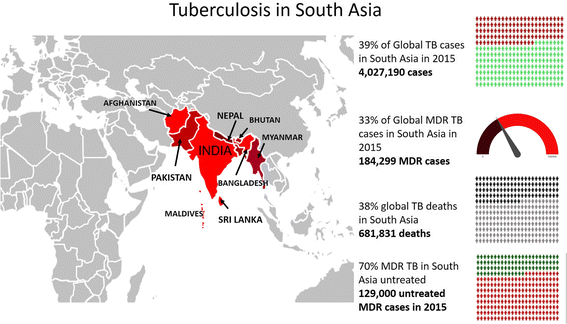Tuberculosis in South Asia: a tide in the affairs of men
- PMID: 29599974
- PMCID: PMC5868053
- DOI: 10.1186/s40248-018-0122-y
Tuberculosis in South Asia: a tide in the affairs of men
Abstract
Background: Tuberculosis (TB) remains the most common cause of infectious disease deaths worldwide. What is perhaps less appreciated is that the caseload of tuberculosis patients in South Asia is staggering.South Asia has almost 40% of the global TB burden with 4,028,165 cases in 2015. This region also has a disproportionate share of TB deaths (681,975 deaths, 38% of the global burden). Worldwide just 12.5% of TB cases are in HIV positive individuals, but much research and investment has focused on HIV-associated TB. Only 3.5% of patients with tuberculosis in South Asia have HIV co-infection. Not surprisingly with such a huge burden of disease, this region has an estimated 184,336 multi drug resistant (MDR) cases among notified TB cases which accounts for a third of global MDR burden. Crucially, at least 70% of the estimated MDR cases remain untreated in this region and MDR treatment success ranged from only 46% for India to 88% for Sri Lanka in the 2012 cohort that received treatment. This region represents many of the drivers of the modern TB epidemic: rapid urbanization and high density populations with dramatically rising incidence of diabetes, a burgeoning and largely unregulated private sector with escalating drug resistance and high air pollution both outdoor and household.
Conclusion: From bacterial biochemistry to policy implementation, we suggest ways in which South Asia can seize the opportunity lead global TB elimination by demonstrating feasibility in some of the world's most densely populated cities and remotest reaches of the Himalayas. Clearly political will is essential, but we cannot defeat TB without understanding how to eliminate it in South Asia.
Keywords: Equity; Infectious disease; LMICs; Research priorities; Tuberculosis.
Conflict of interest statement
NANAThe authors declare that they have no competing interests.Springer Nature remains neutral with regard to jurisdictional claims in published maps and institutional affiliations.
References
-
- World Health Organisation END TB strategy, 2015. Available at: http://www.who.int/tb/post2015_strategy/en/. Accessed March 14, 2018.
-
- World Health Organisation. Global tuberculosis Report 2017. Available at: http://www.who.int/tb/publications/global_report/en/. Accessed March14 2018.
Publication types
LinkOut - more resources
Full Text Sources
Other Literature Sources


